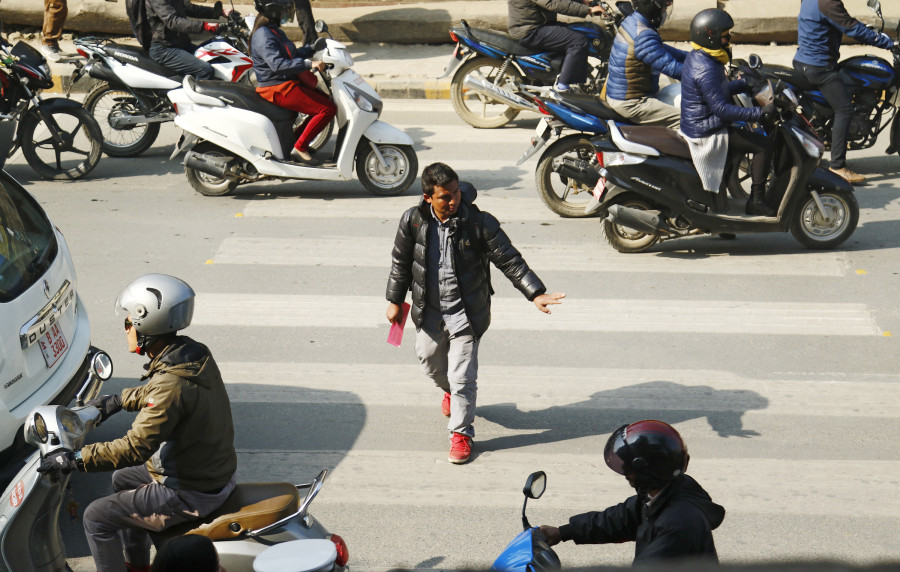Columns
People-friendly roads
While the rest of the world is embracing the concept of ‘streets for people’, Kathmandu is not.
Shaishav Acharya
Contrary to the ever-evolving streets of Kathmandu in the past, the advent of cars and motorbikes has pushed the city towards becoming a dull, monotonous place of motorable roads. While the rest of the world is embracing the concept of “streets for people” rather than “streets for cars”, Kathmandu lags behind. In addition to the reluctance of city officials to welcome new concepts, lack of public awareness, infrastructure, and supportive policies have created a vicious cycle of the dominance of cars over people. Researchers have identified a possible solution to break this cycle, popularly known as tactical urbanism or street experiments.
Street experiments are temporary small-scale interventions to repurpose and reallocate motor street space for active mobility, i.e. "streets for people". Examples include Bogota’s Ciclovia, which is closed to car traffic on Sundays from 7am to 2pm, allowing people to turn to bicycles. Another popular example is Munich’s summer streets. Tactical urbanism has proven successful worldwide in creating sustainable street spaces for people. These experiments benefit the physical and mental health of locals and boost economic opportunities.
Picture in Kathmandu
Street experiments are beneficial, but Kathmandu is reluctant to apply them. Numerous factors account for such hesitation. In order for the street experiments to bring about systemic change, behavioural, institutional, material, and organisational factors come into play. The same factors contribute to the obstruction of the implementation of street experiments.
While private cars were considered quintessentially luxurious modes in the past, the post-90s saw their emergence as a common mode of transport in the valley. The trend of automobile ownership has skyrocketed since then. People were hesitant to use public transport post-Covid-19, and due to a lack of active mobility infrastructure, many shifted to two-wheeler motors. Such factors have contributed to behavioural changes in people towards affinity to private cars. Hence, the locals themselves are not interested (or at least not aware due to decades of car captive environment) in people-centric streets.
Apart from the people, policies from the concerned authorities also seem to reflect an aversion towards active mobility. As published in an article in The Kathmandu Post, the Director General of the Department of Roads seemed apathetic to cycle lanes in Kathmandu valley, citing the Maitighar-Tinkune cycle track. Experts, however, argue that the track’s lack of use resulted from its poor design. Poorly designed streets with no attention to pedestrians and few open public spaces in the valley prove that the same mindset exists in all concerned authorities.
The dreadful condition of public spaces in the valley could also be due to the confusing division of responsibilities among government agencies and authorities. Streets in Kathmandu fall under local governments until they are widened to more than eight metres. After that, they fall under the Department of Roads. The Bagmati civilisation development committee controls river corridors. Further adding to the chaos are excessive administrative divisions within the valley. Thus, even small-scale projects require extensive collaboration between these stakeholders, which is difficult.
All this has resulted in decades of malpractice in street design that caters only to people who can afford motors, but not to the general public. The dire condition of public transit in the city further increases the incentive to buy private vehicles. People walking or cycling nowadays are either cycle enthusiasts, captive users who cannot afford cars, or those who have been prescribed by doctors to walk or cycle daily.
Government intervention
For the tactical urbanism practices to succeed in Kathmandu, both top-down and bottom-up interventions are required. Engineers must prioritise pedestrians over cars in their designs, as even a car user becomes a pedestrian at some point in the journey. Kathmandu’s mayor Balen Shah has been open to radical decisions and is willing to change. This has inspired civil societies and activists to work with the government to amend the decades-long lousy design practices. Experts hope coordination could bring good design practices, including bottom-up interventions. Therefore, better policies and coordination between all stakeholders are imperative.
With freshly elected representatives for the federal Parliament, there is hope that they will bring compelling issues for a systemic change in the field of transportation. There’s a broader consensus among experts that focusing on electric vehicles to reduce emissions in the valley will only lead to a case of “clean congestion”. Instead, our representatives should put forward the idea of active mobility and public transit as a way forward. Pedestrians and public transport modes should be prioritised while designing new road infrastructures. The representatives should also focus on lobbying for a proper administrative system with a clear division of roles in the transportation sector.
We need to work on planning the city infrastructure immediately at a great pace to accommodate the growing demand for mobility in the valley. Creating a conducive environment for research and development should be the prime focus to achieve the goal of sustainable transportation in Kathmandu.




 9.12°C Kathmandu
9.12°C Kathmandu















